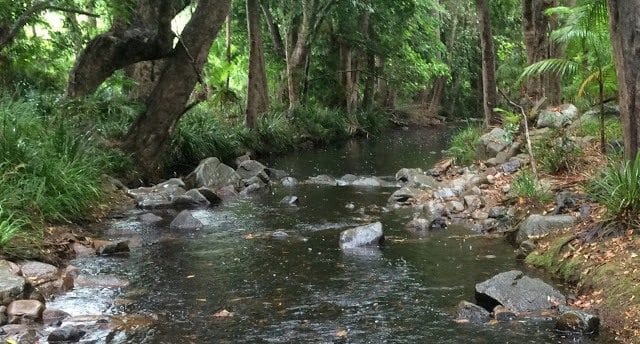We rely on tank water as our source of drinking water, so it is important to have a regular schedule of maintenance and care for this critical element in the design of our permaculture home system. We drink, cook and shower in this clean unfiltered rain water.
For laundry and gardening we have an allocation of water from the ecovillage’s reticulated system drawn from two tributaries of the Mary River. We live in the very upper reaches of this river system.
I aim to use as little of this river water as possible because I want to impact as least as possible on the natural ecological system. There are playtpus, the vulnerable Lungfish, the endangered Mary River Turtle and Australia’s most endangered fish species, the Mary River Cod, living in these waters.
We have managed to reduce our household consumption of river water to about 10% of the standard use in the ecovillage – particularly through having a dry composting toilet and designing our edible garden to be less water dependent. Our main use currently is in the laundry.
 |
| I select species for my edible garden that I know can withstand dry spells, and I focus on building my soil’s capacity to catch and store water. |
We have three large tanks to collect as much water as we can – one on each of our main structures. Our capacity is around 50,000 litres. The highest tank is used by guests and WWOOFers (willing workers on organic farms), the middle tank is emergency water and for gravity feeding to the lower tank should we need it (never have yet!).
Having several tanks also builds resilience into our system. The permaculture principle of multiple elements encourages us to incorporate several design elements to meet our basic needs (water is of course one of these). In our system for example, if one tank becomes contaminated, we still have ample fresh water to drink and implementing the permaculture principle of energy planning we have stored much water high up on the property so we could gravity feed to replenish the main tank.
Although we have had a few storms here in subtropical Queensland lately, the wet season has not really started. Usually by now we have had rain events that have filled our three large tanks to overflowing. Before the rains start it’s really important to check that your tank system is in good order.
Evan and Hugh checked up on our tanks the other day. Firstly they cleared off fallen leaves from the tank top and mesh sieve. They checked and cleared the gutters, leaf guards and downpipes of leaves. This is really important to do before a big rain, otherwise the downpipes can become clogged and all that lovely water cannot reach the tank.
 |
| Evan and Hugh check the water level of the main tank for our house. |
I was impressed, even after a considerable dry time, our main house tank is still two thirds full, the top tank the same and the middle tank is untouched. You can feel where the level is without having to look into the tank. Simply by running your hand down the side of the tank you can feel the temperature change, or you can tap and listen for the change in sound from solid to echoing.
A few good rains now is all it will take to refill our water supplies and keep us going for several more months. Part of our resilience strategy is to use as little as possible in the house, but also to clean what we use through our reedbed system and return it to the land.
I’ll write more about our reedbed system another day. I love it. It is so simple and effective yet so cheap, but also approved through the local council.



I have found this an interesting post, the various ways that you harvest and store water. Water is an issue at Beelarong Community Farm as we run this community garden as sustainably as we can.
We have Brisbane City Council water on tap but are actively working on harvesting rain water, making this a priority. We have installed a number of rain water tanks of various sizes, collecting rain from the roofs of our various sheds. We also used a grant to bore for water this past year, unfortunately, after drilling down over 80 metres it proved to be unsuccessful, but at least we tried. We use permaculture principles in our food forrest and do not water it, the ground is covered with a thick layer of mulch.
Beelarong purchase bales of hay in bulk and we use that as a mulch both in the community garden, and on allotments as another way of cutting down on the need for watering.
We use a reedbed system to deal with the waste from the "WindyLoo" toilet on the site. So will be interested to hear about the redeemed system you are using. Jean.
You are doing amazing things at Beelarong Community Farm. If anyone is every in Brisbane, they should come over and see you. I'd love to come and visit again myself sometime soon – it has been a couple of years since I was there last.
I look forward to hearing more about your reed bed as we are having no end of trouble with our council about ours.